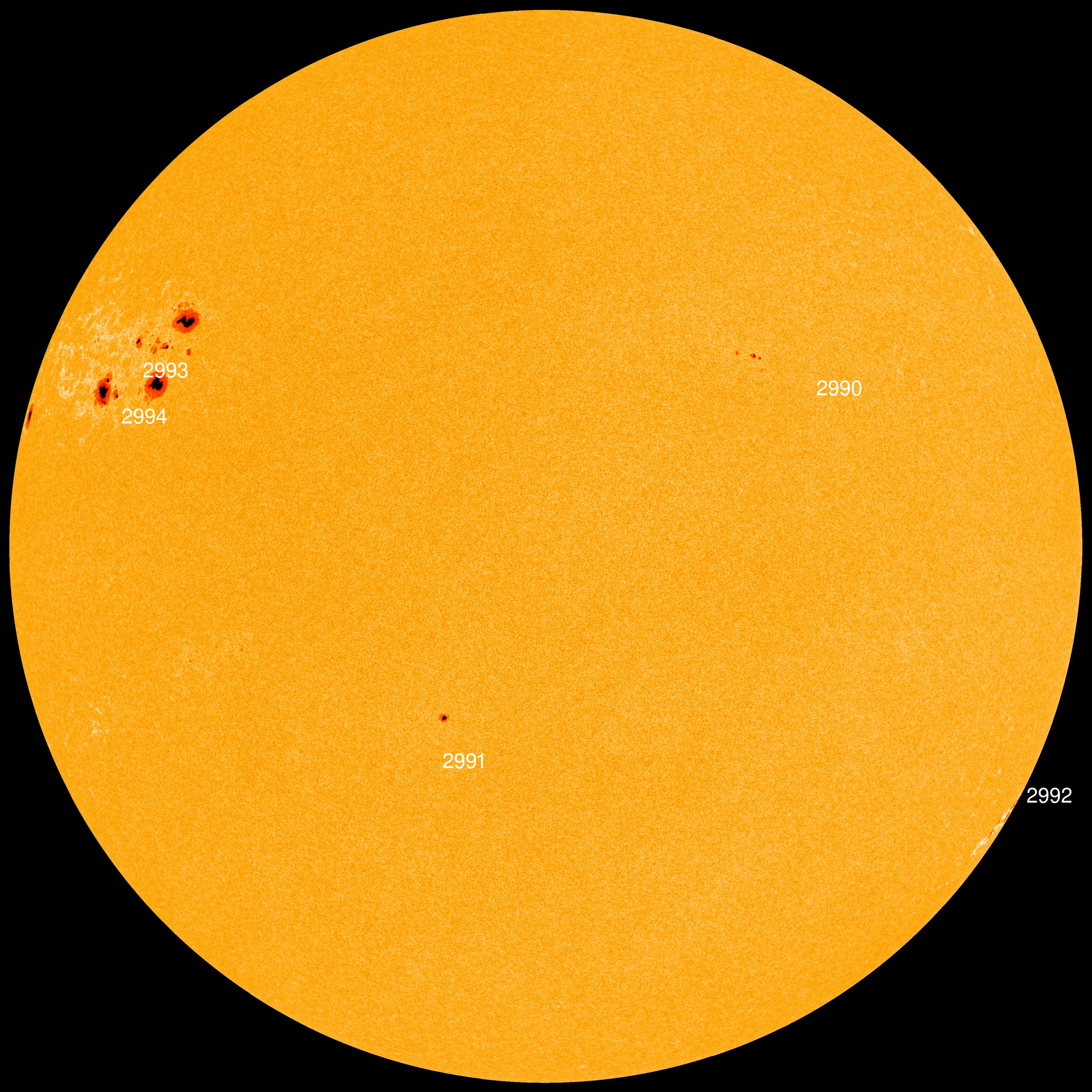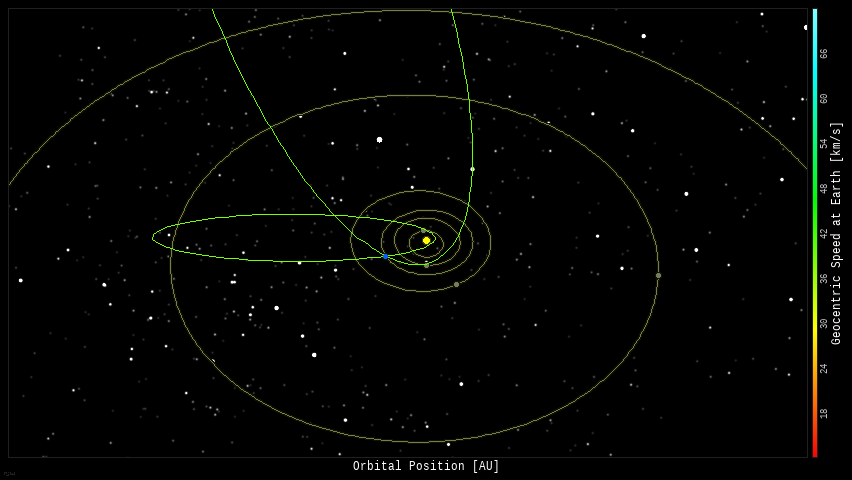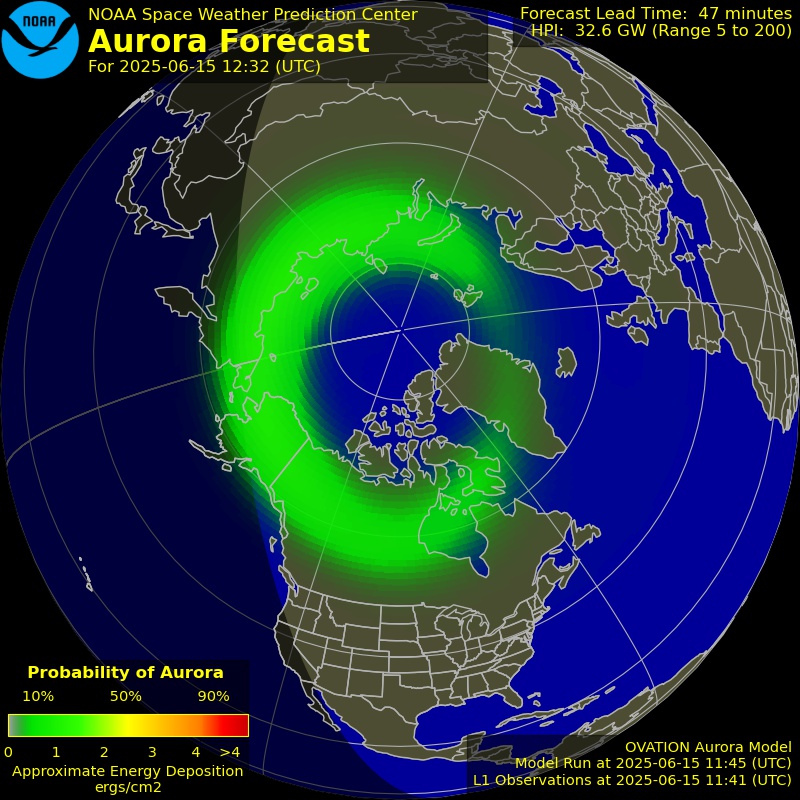The Plane of the Ecliptic
I was showing students in my after-school astronomy club how several planets were visible, all in a line, in the morning sky. I asked them if they knew why they were lined up, and they did not. So I launched NASA’s solar system exploration website’s orrery, and zoomed to the Earth. I framed the image to look like this:

I asked the students if they’d ever heard of the “Plane of the Ecliptic” – they had not. So I zoomed way out in the orrery to the outer solar system, and framed the image to look like the one below. I explained how the major planets all orbit in the same plane (for the most part).

The first thing one of my students said was “Look at Pluto – it’s tilted!” Why YES it is! I then went on to play around with Pluto’s orbit, tilting it back and forth. I explained how “when I was your age,” Pluto was classified as a Planet, and it crossed the orbit of Neptune, but only when seen from top-down. Seen from an oblique angle, Pluto misses Neptune’s orbit by a LOT, and the period Pluto crosses the orbit of Neptune happens when Pluto is far above the plane of the ecliptic.
I gotta tell ‘ya – having an interactive web-based solar system model you can use to show students stuff is REALLY COOL!

Jupiter, Venus, Mars and Saturn continue to appear in the southeastern predawn sky all week.

By next week, Venus and Jupiter will appear much closer; the Moon joins the planets before sunrise on April 24th and 25th – appearing south of Saturn on the 24th, and between Mars and Saturn on April 25th.

The Moon appears west of the star Antares in the southern sky before sunrise on April 19th.

The Moon appears east of the star Antares in the southern sky before sunrise on April 20th.

Just a friendly reminder:


The Moon appears in the constellation Sagittarius before sunrise in the southern sky on April 21st and 22nd.


- The Moon is a Waning Gibbous – rising after sunset, visible high in the sky after midnight, and visible to the southwest after sunrise.
- The Third Quarter Moon occurs on April 23rd – rising around midnight, and visible to the south after sunrise.
- After April 23rd, the Moon will be a Waning Crescent – visible low to the east before sunrise.

If you click on the Moon image above, or click this link, you will go to NASA’s Moon Phase and Libration, 2022 page – it will show you what the Moon looks like right now. If you click the image on that page, you will download a high-rez TIFF image annotated with the names of prominent features – helpful for logging your lunar observations!
Moon News
Back to the VAB with the SLS.

Oh WOW! Sunspots galore, and another one emerging (left side).
Spaceweather.com says: “NOAA forecasters say there is a 75% chance of M-class solar flares today, April 19th, and a 25% chance of powerful X-flares. The most likely source would be sunspot complex AR2993-94, which is crackling with flares as it turns toward Earth..”

Videos courtesy of NASA/SDO and the AIA, EVE, and HMI science teams.
You can view the Sun in near real-time, in multiple frequencies here: SDO-The Sun Now.
You can create your own time-lapse movies of the Sun here: AIA/HMI Browse Data.
You can browse all the SDO images of the Sun from 2010 to the present here: Browse SDO archive.
Amateur Solar Astrophotography
Solar Corona
Solar wind speed is 514.0 km/sec ▲ with a density of 7.2 protons/cm3 ▼ at 1530 UT.
Click here to see a near real-time animation of the corona and solar wind from the Solar & Heliospheric Observatory (SOHO).
Sun News:

- Near-Earth Objects (NEOs) discovered this month: 118, this year: 956 (+10), all time: 28,884 (+10)
- Potentially Hazardous Asteroids (PHAs): 2260 (+5 updated 2022-04-19)
- Total Minor Planets discovered (MPC): 1,194,161 (-28 updated 2022-04-19)
- Total Minor Planets discovered (NASA): 1,113,527 (updated 2021-08-17) – This value has not changed for months.
Upcoming Earth-asteroid encounters:
| Asteroid | Date(UT) | Miss Distance | Velocity (km/s) | Diameter (m) |
| 2022 FN3 | 2022-Apr-19 | 15.1 LD | 6.3 | 39 |
| 2022 GU3 | 2022-Apr-22 | 4.6 LD | 8.7 | 25 |
| 2017 UR2 | 2022-Apr-22 | 19.4 LD | 9.3 | 10 |
| 2020 VN1 | 2022-Apr-25 | 19.3 LD | 2.3 | 9 |
| 418135 | 2022-Apr-28 | 8.5 LD | 10.4 | 466 |
| 2017 XO2 | 2022-May-01 | 18.8 LD | 12.4 | 125 |
| 2017 HG1 | 2022-May-04 | 18.2 LD | 6 | 11 |
| 467460 | 2022-May-09 | 14.9 LD | 11.3 | 513 |
| 2019 JE | 2022-May-11 | 4.9 LD | 7.2 | 20 |
| 2012 UX68 | 2022-May-15 | 2.8 LD | 8.2 | 54 |
| 388945 | 2022-May-15 | 15 LD | 8.2 | 290 |
| 2013 UX | 2022-May-17 | 16.8 LD | 16.3 | 141 |
| 2021 WY | 2022-May-18 | 16.9 LD | 9 | 65 |
| 7335 | 2022-May-27 | 10.5 LD | 13.1 | 1058 |
| 2021 KO2 | 2022-May-30 | 3.1 LD | 14.8 | 9 |
| 2020 DA4 | 2022-Jun-01 | 5.5 LD | 8.9 | 26 |
| 2021 GT2 | 2022-Jun-06 | 9.5 LD | 7.5 | 50 |
| 2018 LU2 | 2022-Jun-09 | 14.8 LD | 10.7 | 16 |
| 2006 XW4 | 2022-Jun-12 | 5.9 LD | 7.3 | 49 |
Asteroid News:

On April 18, 2022, the NASA All Sky Fireball Network reported 10 fireballs!
(10 sporadics)

Fireball News:
If you see a bright meteor or a fireball, please REPORT IT to the American Meteor Society and the International Meteor Organization!

Position of the planets & several spacecraft in the inner solar system on April 19th:

Position of the planets in the middle solar system – April 2022:

Position of the planets in the outer solar system first half of 2022:

Solar System News
Planetary Decadal Survey is out! Uranus to get an orbiter! I was literally bouncing around the house!
In the “It’s hard to believe you can actually do that in Kerbal Space Program” department – a VERY well thought-out interplanetary mission, and amazingly well produced video of a crewed mission to Saturn’s moons Titan and Enceladus. Note: the spacecraft uses some drive tech we don’t have, yet.

See a list of current NASA missions here: https://www.jpl.nasa.gov/missions?mission_status=current

ex·o·plan·et /ˈeksōˌplanət/, noun: a planet orbiting a star other than the Sun.
* Confirmed Planets Discovered by TESS refers to the number planets that have been published in the refereed astronomical literature.
* TESS Project Candidates refers to the total number of transit-like events that appear to be astrophysical in origin, including false positives as identified by the TESS Project.
* TESS Project Candidates Yet To Be Confirmed refers to the number of TESS Project Candidates that have not yet been dispositioned as a Confirmed Planet or False Positive.
Exoplanet News:
April 14, 2022:
Two New Planets, Including AB Aur b
The AB Aur system is the second protoplanetary disk where an embedded exoplanet has been found, which supports the “disk instability” theory of planet formation. Read NASA’s media release and the discovery paper.
The other new planet is TOI-620 b. There are also new parameters for TOI-2076 b, c, & d, TOI-216 b & c, KELT-24 b (MASCARA-3 b), and WD 0806-661 (GJ 3483 b).
Access all of these new data from the Planetary Systems Table and its companion table, Planetary Systems Composite Parameters, which offers a more complete table of planet parameters combined from multiple references and calculations. – exoplanetarchive.ipac.caltech.edu


SpaceWeather.com Realtime Aurora Gallery: https://spaceweathergallery.com/aurora_gallery.html
Latest Aurora Oval Forecast

International Dark Sky Week: April 22-30
- Visit an International Dark Sky Park: https://www.darksky.org/our-work/conservation/idsp/parks/
- If you live in Michigan, visit the Michigan Dark Skies site: https://sites.lsa.umich.edu/darkskies/

NASA STEM
Messier Tour: M13 – The Great Cluster in Hercules

Messier 13 (M13), also known as the Great Globular Cluster in Hercules, is a globular cluster located in Hercules constellation. It is one of the brightest and best known globular clusters in the northern sky. The cluster has an apparent magnitude of 5.8 and lies at a distance of 22,200 light years, or 6,800 parsecs, from Earth. Its designation in the New General Catalogue is NGC 6205.
The Hercules Globular Cluster has an estimated age of 11.65 billion years and contains about 300,000 stars. The estimated mass of the cluster is about half a million solar masses. – messier-objects.com

The Hercules Globular Cluster was discovered by the English astronomer Edmond Halley in 1714.
William Herschel first observed the cluster on August 22, 1779 and resolved it into stars.- messier-objects.com

I noticed that M13 was WAY above the disk of the Milky Way – I wondered what the night sky might look like on a planet orbiting a star in the far-reaches of M13. I travelled to M13, and found a star with planets. I apparently timed it well, because I also had a random comet in scene!

Imagine one side of the night sky being filled with the stars of M13 and the disk of the Milky Way.

And the other side of the sky – looking out into intergalactic space – almost completely empty! I have to wonder what a night sky like this would have done to our study of astronomy throughout the ages.

Cover Image: Messier 13. Credit: Sid Leach, Adam Block, Mount Lemmon SkyCenter.
Messier Object List: [Link]
Software Apps used for this post:
NASA Eyes on the Solar System: an immersive 3D solar system and space mission simulator – free for the PC /MAC.
Stellarium: a free web-based planetarium app. It’s a great tool for planning observing sessions.
SpaceEngine – Explore the universe in 3D and VR!
Worldwide Telescope – operated by the American Astronomical Society (AAS).




